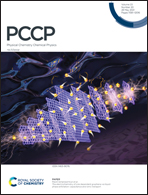Optimizing the dynamic and thermodynamic properties of hybridization in DNA-mediated nanoparticle self-assembly†
Abstract
DNA-directed nanoparticle (DNA–NP) systems provide various applications in sensing, medical diagnosis, data storage, plasmonics and photovoltaics. Bonding probability and melting properties are helpful to evaluate the selectivity, thermostability and thermosensitivity of these applications. We investigated the influence of temperature, nanoparticle size, DNA chain length and surface grafting density of DNA on one nanoparticle on the DNA dynamic hybridization percentage and melting properties of DNA–NP assembly systems by molecular dynamics simulation. The high degree of consistency of free energy estimations for DNA hybridization via our theoretical deduction and the nearest-neighbor rule generally used in experiments validates reasonably our DNA model. The melting temperature and thermosensitivity parameter are determined by the sigmoidal melting curves based on hybridization percentage versus temperature. The results indicated that the hybridization percentage presents a downward trend with increasing temperature and nanoparticle size. Applications based on DNA–NP systems with bigger nanoparticle size, such as DNA probes, have better selectivity, thermostability and thermosensitivity. There exist optimal DNA chain length and surface grafting density where the hybridization percentage reaches the maximal value. The melting temperature reaches a maximum at the point of optimal grafting density, while the thermosensitivity parameter presents an upward trend with the increase of grafting density. Several physical quantities consisting of the radial density function, root mean square end-to-end distance, contact distance parameter and effective volume fraction are used to analyse DNA chain conformations and DNA–NP packing in the assembly process. Our findings provide the theoretical basis for the improvement and optimization of applications based on DNA–NP systems.



 Please wait while we load your content...
Please wait while we load your content...